Opening Thoughts
Dealing with rats can be overwhelming for homeowners and renters who are unfamiliar with pest control. Rats not only damage property but also pose serious health risks. This beginner’s guide breaks down essential rat control and prevention strategies, helping you protect your home and loved ones effectively.
Why Rat Control is Important
1. Health Risks
- Rats carry diseases such as hantavirus, leptospirosis, and salmonella.
- Contaminated surfaces and droppings can lead to foodborne illnesses.
2. Property Damage
- Rats chew on wood, insulation, and electrical wiring, increasing the risk of fires and costly repairs.
3. Rapid Infestation Growth
- Rats reproduce quickly, with a single pair capable of producing hundreds of offspring in a year.
Identifying a Rat Infestation
1. Common Signs
- Droppings: Found near food sources or nesting areas.
- Gnaw Marks: Visible on furniture, wires, or baseboards.
- Noises: Scratching or scurrying sounds, especially at night.
- Greasy Trails: Dark smudges along walls from their oily fur.
- Nests: Made from shredded paper, fabric, or insulation.
2. Areas to Inspect
- Kitchens, pantries, and basements.
- Crawl spaces, attics, and garages.
- Outdoor areas like sheds and trash bins.
Rat Control Methods
1. Trapping
- Snap Traps:
- Effective and humane when used correctly.
- Place traps along walls and in areas with visible rat activity.
- Live Traps:
- Capture rats for relocation, but ensure local regulations allow this.
- Electronic Traps:
- Deliver a quick, humane kill with minimal mess.
2. Baiting
- Poison Baits:
- Place in tamper-resistant bait stations to prevent accidental ingestion by pets or children.
- Natural Alternatives:
- Use food-based baits like peanut butter or cheese for snap traps.
3. Exclusion
- Seal Entry Points:
- Use steel wool, caulk, or metal mesh to block gaps and cracks.
- Install Barriers:
- Door sweeps and weatherstripping prevent under-door access.
- Protect Vents:
- Cover with metal screens to block entry.
Long-Term Prevention Strategies
1. Sanitation
- Keep food in airtight containers and clean up spills immediately.
- Take out the trash regularly and use sealed bins.
- Eliminate clutter that could serve as nesting material.
2. Property Maintenance
- Repair leaks to remove water sources.
- Trim overgrown vegetation and keep firewood stacked away from the house.
- Regularly inspect your home’s exterior for new entry points.
3. Professional Services
- Consider hiring a pest control expert for severe infestations or long-term prevention plans.
Tools and Supplies for DIY Rat Control
- Traps: Snap traps, live traps, or electronic traps.
- Sealing Materials: Steel wool, caulk, metal mesh.
- Cleaning Supplies: Disinfectants, gloves, masks, and trash bags.
- Bait Stations: Tamper-resistant containers for poison or natural baits.
Mistakes to Avoid
- Using Poison Recklessly:
- Unsecured poison baits can harm pets, children, or non-target wildlife.
- Ignoring Small Infestations:
- Even a single rat can quickly lead to a larger problem.
- Neglecting Prevention:
- Failing to seal entry points or maintain cleanliness invites rats back.
When to Call a Professional
- Severe Infestations:
- Visible signs of multiple rats or widespread property damage.
- Health Concerns:
- Presence of diseases or contamination near food sources.
- Hidden Infestations:
- Rats nesting in inaccessible areas like walls or attics.
Final Thoughts
Rat control doesn’t have to be daunting. By understanding the signs of infestation and implementing effective control and prevention methods, you can keep your home safe and pest-free. For more persistent issues, partnering with a pest control professional ensures comprehensive and lasting solutions.
Relevant Links/Sources:
Safe Rodent Control – EPA
DIY Rat Control Tips – CDC
Comprehensive Pest Control – PestWorld
